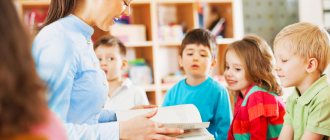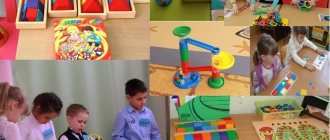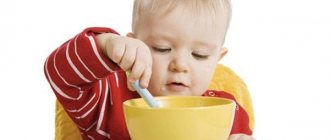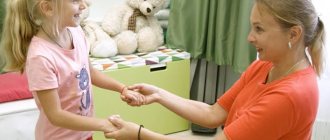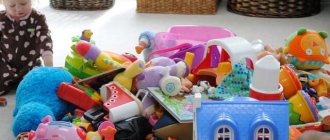Psychological features of the development of preschool children
The article analyzes the psychological characteristics of preschool children.
Key words: psychological processes, mental activity, development.
The psychology of preschool children has its own characteristics. Closer to 4 years, children begin to develop new types of mental activity, they show a desire to talk and listen, they begin to be interested not only in the object itself, but also in its design and methods of its use, and this in turn leads to the emergence of the question “why” in the child’s speech. ? (this question is asked so often that children during this period are called “whys”) - the adult who answers the questions becomes an authority for him.
Speech develops gradually and also gradually begins to accompany any of the child’s activities (drawing, playing, counting, observing, etc.). A distinctive feature of speech development can be called the desire of children to invent their own words, using already familiar ones as a basis. By the age of 5–6, a child can coherently express his thoughts, structure phrases correctly, he pays attention to his words and the situation in which they are spoken; at this age, internal speech is already sufficiently formed, which allows the child to plan a future statement.
L. N. Leontyev wrote that in the preschool years the child “ties the first knots, establishes the first connections and relationships that form a new, higher unity of activity and at the same time a new, higher unity of the subject - the unity of the personality,” he said that therefore The period of preschool childhood is important, because in it “the mental mechanisms of the personality take shape” [1]. During this period, the child begins to actively explore the world around him, make discoveries, and get acquainted with objects in the house, in kindergarten and on the street. The child examines, listens, touches, tries, studies the properties, capabilities and limits of objects. Since during this period mental activity begins to actively work and develop, the child rethinks many objects already familiar to him, analyzes them in ways accessible to him - didactic games, dancing, modeling from clay or plasticine and drawing will be relevant for this period in education . By school, children have formed certain evaluation criteria, guided by which they express their attitude towards the world, and their relationships with others gradually acquire a moral character, and feelings of camaraderie and friendship deepen.
In preschool age, there is an active development of cognitive processes, for example, sensory development, which acquires a number of features: sensory standards are assimilated, focus, planning, controllability and awareness of perception grow. Thinking changes, each new stage of development occurs thanks to the previous one, the child masters new ways of thinking and mental actions. Thinking itself goes from the visual-effective to the visual-figurative and further to the verbal-logical, becoming extra-situational. The effective form of thinking plays an important role for children, since at this stage the internalization of thinking occurs and at the same time a restructuring of practical actions occurs; with imaginative thinking in children, the pre-analytical stage of thinking predominates - the child thinks in patterns, certain images that he has preserved on the basis of perception.
Mastered speech develops reasoning, which becomes a way to solve mental problems, problematic thinking appears (curiosity develops and questions arise). The child discovers more complex connections and relationships, learns to reason, engages in experimentation (it helps to understand connections and relationships, apply one’s own knowledge and strengths), and develops independence and perseverance. Perception becomes more complex, for example, recognition of a part of an object evokes its integral image and comparison with the name of this object; the child no longer needs to touch it with the perceiving organ. When perceiving pictures for preschoolers, the question asked to them plays an important role, otherwise the process of analysis may become difficult, and when perceiving space, children are already able to navigate, relying on visual perception, but may have difficulty distinguishing the left and right sides.
The development of thinking has a close connection with speech, which in turn goes from situational, associated with a specific event, to a universal means of communication and connection. Speech acquires expressiveness and new forms, the child learns the laws of language by “interacting” with words, learns a coherent and logical presentation of thoughts, reasoning - this is how speech becomes a means of cognition and thinking. Expressed functions of speech appear: planning function for solving practical and intellectual problems; sound function, responsible for words as objects of cognition and development of written speech. Speech becomes a specific type of activity for the child, which has various forms (listening, conversation, reasoning, stories), and at the end of phonemic development the child correctly distinguishes and pronounces sounds [2]. At 5–6 years old, a child understands fairy tales and short stories well, can answer questions asked during the story or after finishing a story he has heard, and can come up with a short story himself or an alternative ending/direct continuation to an already familiar fairy tale.
Memory also develops during the entire preschool period. A. A. Lyublinskaya described what transitions occur during the development of memory, for example, single ideas from the perception of a specific object are replaced by operating with generalized images; logical comprehension and clearly differentiated and dynamic images appear that reflect the diversity of connections [3]. For younger preschoolers, the image is created on the basis of practical actions and only then in speech, when, like for older preschoolers, the image arises on the basis of mental analysis and synthesis. It is possible to highlight the features of memory development in preschool age: in children, predominantly involuntary figurative memory, but when combined with speech and thinking, it begins to acquire an intellectual character; verbal-semantic memory provides indirect cognition and expands the scope of cognitive activity; elements of voluntary memory are formed and prerequisites are formed that transform the memorization process into a specific mental activity, which in turn ensures mastery of logical memorization techniques; With age and accumulation of experience (behavior and communication with adults and peers), memory is included in the development of personality [2].
In the preschool period, personal mechanisms of behavior arise and the motivational sphere of the individual is actively formed, as well as the primary subordination of motives, and the development of will and arbitrariness occurs [1]. An important place among the motives is occupied by the cognitive motive, which is typical for older preschoolers, since at the age of 5–6 years mental activity begins to acquire an independent character, which allows children to “gain” experience. Thus, intellectual activity provides children with the opportunity to solve new problems without outside help, establish cause-and-effect relationships and hidden properties and relationships of objects [4]. Children from the age of 3 begin to show independence, and with age they understand that their capabilities have increased, the tasks and goals that they set for themselves also increase, as do the efforts put into their implementation, and a craving for experimentation appears. By the age of 5–6 years, children have a fairly high will and endurance, the child is already able to predict certain events that may appear on the way to the desired goal and, to the best of their individual characteristics, tolerate them calmly, while in a child of 3–4 years this can take more energy and time to cope with your immediate desires, which is willpower training.
Attention in children is involuntary, and increased stability of attention is observed in studies that include children looking at pictures, describing them, and listening to stories. By the age of 6–7 years, attention becomes voluntary - children can control attention, hold and direct it, using techniques that they adopted from adults.
The leading activity for preschool children is play. A game (especially a role-playing game) is a special form of activity for children; it helps them reconstruct and adopt social experience. One of the first role-playing games in a child’s “arsenal” is usually a “family game” or “mother-daughter game” - an adult shows the child how to “play”, that is, perform certain actions with certain objects, at first he simply repeats what the adult showed , but subsequently the child himself adds new elements to the game, guided by the experience gained from life and fantasies based on it. Later, various professions appear in games, which the child becomes familiar with; in games, he tries on these professions and creates different combinations. With the help of role-playing games, children become aware of the norms of social behavior, social roles, and the moral behavior of each child involved in the game develops; in addition, they learn to interact in a team, choose ways to convey information to fellow players and build their own line of behavior. With age, the relationships in games between children become more complicated; if 4-year-old children are interested in manipulating objects characteristic of a certain profession, imitating the actions of an adult, then for older children, for example, six-year-old children, they are mainly interested in the social function (playing “hospital”, the child is interested in the condition of the “patient”, his “complaints”, tries to show concern, thereby fulfilling the social role of a doctor).
Literature:
- Leontyev A. N. Problems of mental development. - M.: Publishing house Moscow. University, 1981. - 584 p.
- Uruntaeva G. A. Preschool psychology. - M.: Publishing House, 2001. - 336 p.
- Lyublinskaya A. A. To the teacher about the development of the child. - M.: Education, 1972. - 256 p.
- Vinogradova E. L. Conditions for the formation of cognitive motivation of preschoolers 5–6 years old // Psychological Science and Education. - 2004. - No. 2. - P. 43–46.
Baby up to 1 year
Infancy is characterized, first of all, by emotional communication, which is the main thing at this stage. All actions of a newborn baby are performed on an instinctive level, unconsciously: he sucks the breast or pacifier, moves his arms and legs, cries when he wants to eat or experiences discomfort. But only a few months will pass, and the baby will begin to consciously smile, respond to his mother’s smile with the first “aha” and purposefully reach for the toy. Here, an important stage of psychological development will be the active use of hearing and vision. Having reached the age of 6-8 months, the baby will learn to crawl and begin to explore the world around him more actively. He is already able to feel the connection between the object and the word denoting it. The first words open his vocabulary. By the first anniversary of birth, the baby shows the intention of communicating with people. He already chooses who he likes and who he should stay away from.
Development of memory, thinking and imagination of a preschooler
An important feature of preschool age is represented by the formation of a new system of mental functions. At their center is memory, which is capable of predetermining other processes.
The thinking of a preschooler is largely determined by memory. For him, thinking means remembering, taking past experience as a basis or modifying it. At no other time can thinking show such a high correlation with memory.
The task of the mental act lies not in the logical structure of the concepts themselves, but in the specific memory of one’s own experience. The fact that memory becomes the center of a child's consciousness leads to significant consequences characterizing mental development. Children acquire the ability to act within the framework of general ideas. Their thinking ceases to have a visually effective character, breaking away from the perceived situation. Thus, there is a discovery of the possibility of establishing connections between general ideas that were not given in direct sensory experience.
Imagination is one of the most important new formations of the preschool period. It has a lot to do with memory. In both cases, children act in terms of images and ideas. Memory in some cases can be considered as a “reproducing imagination”. In addition to reproducing images of past experiences, imagination makes it possible to build and create something new (something that was not previously in the child’s experience).

